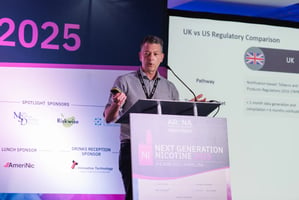Day One Overview
Global Cosmetics Regulation Is Evolving – Are You Ready?
Events

Nov 21, 2025 | Published by Anas Hussain
Events
At this year’s Global Cosmetics Regulations 2025 conference, leading regulators, toxicologists, and industry experts came together to discuss one thing: change. And it is happening fast.
Our Consultant Toxicologist, Anas Hussain, attended the event and captured the key developments shaping the future of cosmetics compliance and product safety around the world.
Accelerating Global Regulatory Change
Regulatory reform is picking up pace across all major markets. The EU is driving the charge with rapid updates to the Cosmetics Regulation, while China is tightening controls under Cosmetic Supervision and Administration Regulation (CSAR). In the US, Modernization of Cosmetics Regulation Act (MoCRA) continues to reshape manufacturer responsibilities. Latin American regulators are moving toward greater regional harmonisation and digitalisation, while many ASEAN authorities are building and strengthening digital infrastructure to support cosmetic notification and post-market surveillance.
For cosmetics businesses, keeping pace with updates across all these regions is becoming a major strategic priority.
Ingredient Scrutiny Is Intensifying
One of the most consistent messages from the event: expect more scrutiny on ingredients.
EU regulations are leading a wave of restrictions targeting:
- CMRs (Carcinogenic, Mutagenic or Reprotoxic substances)
- Allergens
- PFAS
- Microplastics
- Endocrine Disruptors
These changes are influencing global regulatory agendas, with Mercosur nations and China beginning to align more closely with EU approaches.
Non-Animal Safety Science Is Becoming the Norm
The shift toward Next Generation Risk Assessment (NGRA) and New Approach Methodologies (NAMs) is gaining serious traction. Organisations like SCCS, OECD and ICCR are setting the stage for exposure-led, mechanistic science to replace traditional animal testing.
Cosmetics brands that invest early in non-animal methodologies will be best placed to demonstrate compliance in the near future.
A Global Push for Modernisation
Modernisation is not just about ingredients. From digital submission portals to stronger post-market surveillance, regulatory frameworks across the globe are becoming more structured, more technical, and more rigorous.
US regulators are undertaking the biggest UV filter review in 26 years. In China, structured NCI management is creating new challenges for international businesses. ASEAN’s ACD is gradually harmonising requirements, though implementation remains inconsistent between countries.
Claims and Classification Under the Microscope
With the rise of "clean beauty" and sustainability-focused marketing, claims substantiation is a critical area of concern. Speakers reinforced that misleading environmental claims are now high on enforcement agendas, and classification of borderline products is increasingly based on marketing claims rather than just composition.
Brands must ensure both product classification and claims are supported by robust, transparent evidence.
What This Means for Brands and Safety Assessors
Faster-moving regulations, stricter safety expectations, and increasing alignment around ethical science are shaping the cosmetics industry.
For manufacturers, safety assessors and regulatory professionals, now is the time to:
- Strengthen global compliance strategies.
- Invest in NGRA and non-animal testing models.
- Stay ahead of ingredient and claims scrutiny.
- Reassess how digital tools and automation can support efficiency and readiness.
At Broughton, we help cosmetics brands navigate complex international regulations with confidence. From toxicological assessments and regulatory consulting to safety evaluations, our team of experts are here to support your global compliance journey.
Get in touch to find out how we can support your cosmetic product development and regulatory needs.



